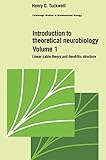Introduction to theoretical neurobiology : linear cable theory and dendritic structure
Material type: TextSeries: cambridge studies in mathematical biology 08Publication details: Cambridge Cambridge University Press 1988Description: xii, 291pISBN:
TextSeries: cambridge studies in mathematical biology 08Publication details: Cambridge Cambridge University Press 1988Description: xii, 291pISBN: - 9780521022224 (pbk.)
- 599.0188 TUC
| Item type | Current library | Collection | Call number | Vol info | Status | Date due | Barcode | |
|---|---|---|---|---|---|---|---|---|
 Book
Book
|
Plaksha University Library | Biology | 599.0188 TUC (Browse shelf(Opens below)) | Volume l | Available | 003738 |
The human brain contains billions of nerve cells whose activity plays a critical role in the way we behave, feel, perceive, and think. This two-volume set explains the basic properties of a neuron--an electrically active nerve cell--and develops mathematical theories for the way neurons respond to the various stimuli they receive. Volume 1 contains descriptions and analyses of the principle mathematical models that have been developed for neurons in the past thirty years. It provides a brief review of the basic neuroanatomical and neurophysiological facts that will form the focus of the mathematical treatment. Tuckwell discusses the mathematical theories, beginning with the theory of membrane potentials. He then goes on to treat the Lapicque model, linear cable theory, and time-dependent solutions of the cable equations. He concludes with a description of Rall's model nerve cell. Because the level of mathematics increases steadily upward from Chapter Two some familiarity with differential equations and linear algebra is desirable.
There are no comments on this title.

